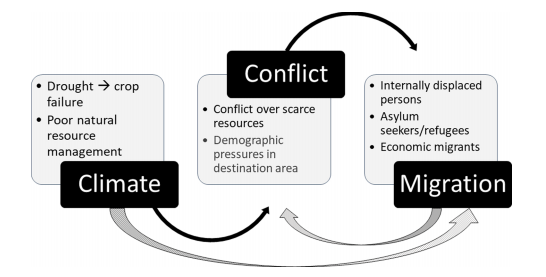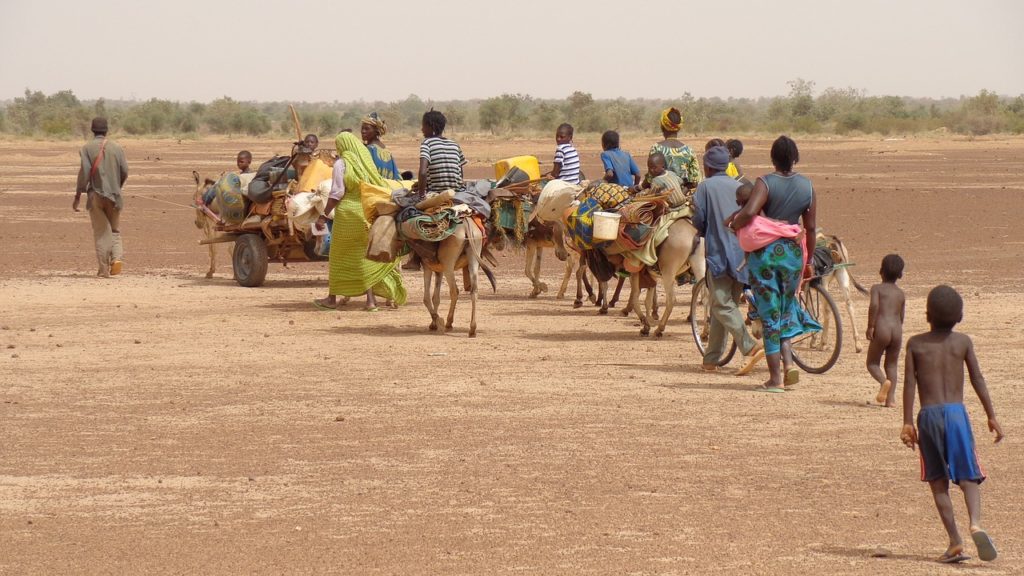Discourse around the climate crisis tends to focus on the weather-related effects, such as rising sea-levels and intense hydrological incidents such as flooding and droughts, as well as the direct impact on human lives, like famines, forced migration and geopolitical shifts. Less has been said about the impact the climate crisis could have on human conflict and the implications it could present for the future.
—
Cornell University professor Gary Evans explored this proposition and found a link between the climate crisis and large-scale social behaviour. He identified rising temperatures, increased frequency and severity of droughts, flooding and storms, and air pollution as the main drivers of climate change-related societal disruption.
Evans categorised these impacts into three groups, namely heat, weather disasters and air pollution. This is how the fate of climate and society has intertwined:
You might also like: Asia’s Battle Against Plastic Waste

Which current conflict is a direct result of climate change?
- Temperature, Mental Health And Quality of Life
Starting from 1993, an 11-year long analysis of all deaths in the United Kingdom concluded that when temperatures exceeded 18°C, there was a 3.8% increase in the relative risk of suicide for each 1°C increase. Indeed, when ambient temperatures rise well above mean levels, mental health admissions to hospitals increase. However, while temperature is associated with mental health and quality of life, the direct association of rising temperatures with mental health is stymied by the complexity of suicide cases.A panel study examining 67 countries concluded that the warmer the coldest month of the year, the happier the country and the warmer the hottest month of the year, the less happy the country. The study included variables such as economic indicators, sociocultural factors and life expectancy to rule out alternative explanations for the differences in happiness.
Furthermore, the study used projected changes in temperature to predict happiness levels over 30 and 60 years and found that as temperatures increase, countries at higher latitudes may become happier, while tropical and subtropical countries may become unhappier.
- Social Interaction, Crime and Conflict
As the climate crisis intensifies, an increase in crime could be seen, particularly at lower latitudes. A study found that given existing US data on assaults, murders and annual temperatures in a set of 50 US cities over a 48- year period, an average annual increase of 2°F in the US would result in a staggering 24,000 additional murders/assaults each year.Studies looking at fluctuations in temperature in the same populations over time show increased intergroup conflict, especially in low income, agriculturally-dependant regions. For example, increased temperatures result in reduced rainfall, damaging crop yields and leading to economic distress and resource scarcity. Additionally, economic pressure caused by insufficient infrastructure and unemployment may exacerbate climate-related migration.
The climate crisis may strengthen authoritarian trends globally, as discussed in a study published in the Journal of Environmental Psychology. Increased authoritarianism is directly linked to an increased perceived threat level; that is, situations that are troubling or distressing to an individual, which may result in populations becoming more polarised and discriminatory towards minorities and those at the margin of society.
Eritrea is one such example. 5,000 refugees flee from its borders every month. Not incidentally, it’s one of Africa’s most food-insecure nations and and a one-party state with one of the worst human-rights records in the world.
- Armed Conflicts
Armed conflicts over a 30-year period were coincident nearly 10% of the time with major heat waves or droughts and in countries with a high degree of ethnic fragmentation, the incidence was 23%. According to an article published in PNAS, this has far-reaching implications as countries vulnerable to climate change are set to suffer disproportionately from rising temperatures. The most fragile states often couple an economy of basic subsistence with deep ethnic divides. Middle Eastern countries with quarreling ethnic groups, for example Syria and Afghanistan, both experienced prolonged droughts that ravaged agricultural output at crucial moments in their recent history. The Pentagon also found a causal link between the climate crisis and human conflicts (for example, the ongoing Syrian conflict), but only when other conditions and factors such as drought severity and the pre-existing likelihood of conflict were present at a high enough level to ignite armed conflict.
Overall, Evans’s review indicates that behavioural changes stemming from rising temperatures will have mostly negative consequences and that without effective intervention, humans will become more violent and mental health will suffer.




















